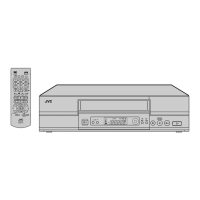
Do you have a question about the JVC HR-S5965EK and is the answer not in the manual?
| Type | VCR |
|---|---|
| Number of Heads | 4 |
| Audio System | Hi-Fi Stereo |
| Remote Control | Yes |
| Tuner | Yes |
| Timer | Yes |
| Video Format | VHS |
| Recording Speed | SP, LP |
| Playback Speed | SP, LP |
| Video Output | Composite |
| Inputs | Composite, S-Video |
| Outputs | Composite, S-Video |
| Power Supply | AC 220-240V |
| Audio Output | Stereo |
Covers dangerous voltage, fire, shock hazards, and exposure to moisture.
Includes reading precautions, copyright notice, and UK power plug connection.
Advice on disconnecting power, internal servicing, and standby mode operation.
Essential guidelines for safe operation, including connections and handling.
Visual representation of the VCR's front panel controls and indicators.
Visual representation of the VCR's rear panel connectors and inputs/outputs.
Visual representation of the VCR's remote control buttons and functions.
Detailed explanations of front panel controls and indicators.
Detailed explanations of rear panel connectors and inputs/outputs.
Explanation of symbols and indicators shown on the VCR's display panel.
Detailed explanations of remote control buttons and their functions.
Initial advice, safety points, and reading recommendations for the manual.
Steps for unpacking and checking the VCR and its accessories.
Automatic VCR setup including tuner channel and clock configuration.
Choosing the correct TV channel or AV mode for viewing.
Verifying the successful completion of the auto setup process.
Finalizing the quick start procedures and preparing for use.
Loading, playing, stopping, and ejecting video cassettes.
Basic procedures for recording TV programs or other video sources.
Setting up timed recordings using VIDEO Plus+ or manual methods.
Steps for inserting a cassette and initiating playback.
How to stop playback and safely remove cassettes from the VCR.
Controls for fast winding tapes in both directions.
Procedure for cleaning the VCR's video heads using a cleaning cassette.
Pausing playback and advancing the picture frame by frame.
Using slow motion playback and variable speed search.
Visually searching through recorded content for specific scenes.
Selecting TV channels and setting tape speed (SP/LP) for recording.
Initiating, pausing, and resuming the recording process.
General recording tips, tape status display, and counter reset.
How to record one program while simultaneously viewing another.
Resuming recording automatically after a power interruption.
Quick setup for recording in 30-minute increments.
Navigating to the VIDEO Plus+ screen for programming.
Inputting program codes for automated recording via TV listings.
Verifying programmed recording details like channel, time, and tape speed.
Exiting the programming mode and returning to the standard TV screen.
Setting the VCR to timer standby mode to await programmed recordings.
Navigating to the manual timer programming screen.
Manually setting recording start time, stop time, and date.
Setting the VCR for manual timer recording.
Reviewing, cancelling, or changing programmed timer recordings.
Options to enhance and optimize picture performance.
Features for recording based on tape type, system, and quality.
Adjusting audio settings and locating specific scenes on tape.
Configuring VCR settings and connecting external devices.
Fine-tuning tape tracking for optimal picture quality.
Correcting vertical picture vibrations from unstable recordings.
Choosing different picture enhancement modes like AUTO, EDIT, or SOFT.
Using the S-VHS ET feature for enhanced recording quality on VHS tapes.
Selecting between S-VHS, S-VHS ET, and standard VHS recording modes.
Turning the Biconditional Equalised Signal Tracking system ON or OFF.
How the B.E.S.T. system optimizes picture quality during recording and playback.
Receiving stereo and dual-language audio broadcasts.
Choosing available audio tracks for playback (Hi-Fi, Bilingual, Mono).
Locating content using skip search or index markers.
Quickly reviewing recently recorded programs.
Connecting and configuring the VCR for automatic satellite program recording.
Key considerations, limitations, and incompatibilities for auto recording.
Configuring the L-1 output (VIDEO or S-VIDEO) for editing purposes.
Configuring the L-2 input (VIDEO or S-VIDEO) for editing purposes.
Wiring and setting input/output modes for dubbing tapes between VCRs.
Initiating playback on the source VCR and recording on the target VCR.
Enabling or disabling the display of on-screen information.
Reducing power consumption by turning off the display and panel.
Automatic tape speed adjustment for timer recording to fit tape length.
Automatic timer engagement and auto power off after inactivity.
Functions like repeat playback and next function memory.
Linking VCR audio outputs to a stereo system for playback.
Manually configuring the VCR's video output channel for TV connection.
Scanning for and storing available TV channels automatically.
Manually adding and configuring TV channels and their details.
Renaming stored TV stations for easier identification.
Removing channels from the VCR's memory.
Rearranging the order of stored TV channels.
Adjusting the frequency for stored channels for optimal reception.
Reference list of station identifiers for channel setup.
Manually setting the VCR's internal time and date.
Using broadcast time signals to synchronize the VCR's clock.
Common questions and answers related to VCR playback operations.
Common questions and answers related to recording and timer functions.
Resolving problems related to power supply and tape movement.
Resolving picture and audio problems during playback and search.
Resolving issues with starting recording, timer programming, and tape loading.
Addressing miscellaneous VCR issues like channel scanning and settings.
Details on power, dimensions, weight, and format.
Technical details of signal systems, frequency ranges, and tuner capabilities.
List of accessories provided with the VCR.